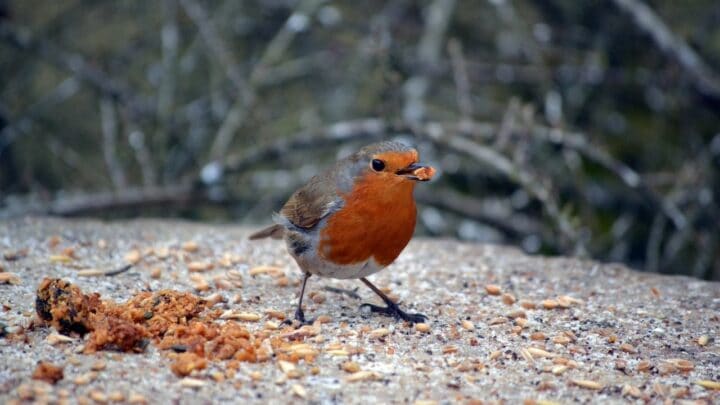Robins are popular backyard visitors. However, they don’t frequent bird feeders despite being among the most prevalent backyard birds.
So, what do robins consume, and what can humans offer them to eat that is healthy and appealing?
What to Feed Robins
Robins eat a mixture of 40% protein in the form of worms, snails, grubs, and other insects (spiders, grasshoppers, termites, crickets) and 60% fruits (grapes, chokecherries, cherries, dogwood, crabapples, and hawthorn). They also love berries like honeysuckle, mulberries, holly, juniper, blueberries, and winterberries.
A Robin’s Menu: Specific Foods Robins Eat
Depending on where they are foraging and what they can capture, they have been seen eating eggs, tiny snakes, small fish, frogs, and skinks.
Suffice to say robins are not super picky about their natural food choices, especially during the cold wintry months where the food is scarce.
But, if they do get the choice, these are what our little robins love to munch on:
- Vine Fruits – Wild and cultivated and domestic grapes
- Berries – Winterberries, Blueberries, honeysuckle, mulberries, holly, and juniper
- Insects – Grasshoppers, spiders, beetles, cricket’s termites, crickets, and other insects are among their favorites
- Tree Fruits – Hawthorn, chokecherries, cherries, dogwood, and crabapples
- Garden Critters – Caterpillars, earthworms, grubs, snails, and grubs
Fruits
Since 60% of a robin’s diet consists of fruits, if you only have one tree or no fruit trees you can offer them the fruits, they enjoy by cutting them into pieces.
The robins can handle to swoop down and grab and bring back to their nest.
Most of the fruits that birds enjoy can be found all around if not in your yard, maybe a family member or even a friend’s, if not try a public park.
After you cut up the pieces of fruit, place them near or on the bottom shelf of a feeding tray, in the garden on the ground, or any place, a robin may look for food or easily spot it, such as a garden bench or a stone wall.
How Robins Find Their Food
The robin’s senses are very sharp. Their main meal aside from fruit is worms.
They will eat any type of worm, but they prefer earthworms. You may be surprised to know that robins have a unique way of finding these delish worms.
Vision
Birds, such as robins, detect worms mostly by sight. Birds have excellent vision, and their acute eyes can identify a worm as it emerges from the earth.
They can also detect slight changes in the grass and soil as the worms move just beneath the surface, motions that reveal where a worm is.
Touch
Another theory is that robins can detect minute worm movements in the dirt beneath their feet.
A nearby bird may be alerted by the soil upheaval or the grass blades’ subtle motion ruffled by worm activity, leading to a successful worm search.
Touch, like sight, is unlikely to be the only factor in a robin’s successful worm-hunting.
Hearing
When worms move around, they disturb the earth, causing microscopic particles of dirt to rub together and make noises that people can’t hear.
Birds, on the other hand, have extremely acute hearing, and this information is one element of how robins locate snails, worms, grasshoppers, and other food sources in the dirt.
However, it is only one indication, and extensive research has shown that no birds can detect worms only by hearing.
How to Help a Robin Find Worms
While robins do a great job finding their own worms, there are times when they can use a little help.
If a robin has a baby in the nest, they are only gone from the nest for about ten minutes and that’s not a lot of time to find and capture a worm so it can be brought back to feed the baby bird.
Weather conditions and changing seasons can also be an issue for robins in search of their worm dinner.
Plus, why not be a good human and help them out?
1. Early in the morning, water your lawns and plants. This should bring the worms near the surface or perhaps urge them to come up from the turf in search of oxygen, allowing hungry robins easier access to these worms.
2. Aeration and thatch disposal should be done once a year to keep the grass in good shape. This allows birds to access the soil more easily to retrieve worms from looser, less compacted soil.
3. Shorter grass should be used to keep the lawn uniformly manicured. This allows birds to view the dirt and detect movement more easily. It also makes reaching the next mouthful simpler for them.
4. Start leaving fallen leaves undisturbed for birds to eat. Under leaves and wood mulch, the wet, biologically rich soil is a perfect home for worms, making it simpler for birds to discover delicious morsels.
5. In vegetable gardens or flower gardens where birds may be searching for worms, avoid using weed cloth or other covers. Even if robins discover worms, they cannot readily penetrate their coverings.
6. At a bird-feeding station, put mealworms in low tray feeders or tiny dishes. The simple treat will be appreciated by all birds, including robins.
Frequently Asked Questions about What to Feed Robins
Do Robins eat seeds and nuts? They seem to avoid bird feeders.
Robins love sunflower seeds, nuts, they even love cheese and raisins. Just place the food near the bird feeder, preferably on the ground, and they will scoop them up.
Do robins fight with other bird species over food?
Robins are not fighters. In fact, they are fearful of a lot of other birds and animals. They will abandon any food they capture if another bird tries to take the food or attack them.
Conclusion
Robins are beautiful yet complex birds. The males do look out for the females when they have a baby in the nest.
For the most part, robins keep to themselves.


